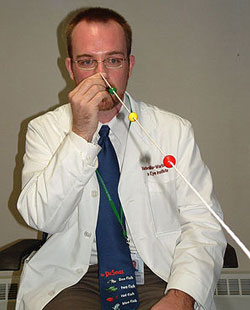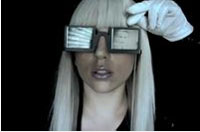LET US CONVERGE FOR A WHILE
A successful vision therapy practice has many proven techniques and interesting tools (called orthoptics) at their disposal. These tools and techniques are used over an extensive period of time across varying therapy phases. Some of the most common are Brock strings (used for suppression/convergence insufficiencies), vectograms (training base in / base out ranges), loose lenses (training base in / base out ranges), random Dot Pads (training base in / base out ranges), eccentric circles (training base in / base out ranges), lens flippers (accommodation through refractive powers), prism flippers (accommodation through refractive powers).

Other techniques used are computer assisted home testing, Marsden Balls (develops hand-eye coordination and motor skills), rotational trainers (develops hand-eye coordination), and saccadic fixators (develops efficient eye tracking). Although many adolescents are traditionally thought of as vision therapy patients, age is not a deterrent to the achievement of successful vision therapy outcomes. Each patient doesn't necessarily require therapy using all the techniques, but usually a combination of them that are varied over time. The techniques are generally classed into one of two categories. First is Orthoptics, which has subsections of strabismic and non-strabismic. The second category is called behavioral. Some patients will have therapy that has some overlap of both categories. The underlying purpose of many vision therapy sessions can be simple but can vary dramatically per patient. For example, one may need occulomotor strengthening which is very common, whereas another may require improved saccadic fixation (reading a series of sentences without any jumbling of the words or letters within the words).
Some patients benefit from yoked prisms to expand the field of vision or to correct posture and gait. Other patients desire an improvement in hand-eye coordination for occupational reasons (usually professional athletes).
A typical vision therapy regimen may go as such. First, a patient has an initial exam to find diagnoses and develop a therapy plan. Usually the patient comes once a week for 16-20 weeks with periodic progress checks to measure improvement. Each session may last 30 minutes with one or more of the therapy tools. (i.e. vectograms, random dot, flippers etc.) A thirty-minute limit on each session is important to maintain since significant eye fatigue usually occurs. The symptoms will usually be treated by the end of the 16-20 sessions but if more improvement can reasonably be expected with continued therapy, the doctor may extend the sessions. Brain scans are starting to elucidate more symptoms and syndromes traditionally considered separate from the visual systems and are now linked. In the future more diagnoses are going to be connected to the visual systems and thus remedied by vision therapy.

PLASTIC VISION
Activity dependent neuroplasticity is shaping the future of vision therapy. Amblyopia treatment is a shining example of this. When vision therapists approached Amblyopia as a visual cortex problem and used the principles of brain plasticity patients recovered binocular vision and at any age! Their groundbreaking method uses special LCD goggles and measured contrast stimuli to establish just noticeable difference thresholds. When a binocular threshold limit was found, clinicians gradually began to balance each eye's limit. Towards the end of the therapy each eye had a very similar and functional threshold limit and thus binocular vision. The method is not a panacea; some patients with strabismus find it difficult to align contrast images. However the treatment has been successful and has an exciting future. Dr. Quinlan and her rat lab demonstrated another important insight to Amblyopia and brain plasticity. She induced Amblyopia in rats by patching and measured their electrical brain activity. Noting the unusual brain activity she removed the occlusion and gave the rats time for visual recovery. No recovery was measured until she placed the rats in total darkness for 3-10 days. After the dark room exposure all the rats had a total neuropsychological recovery. The dark room exposure enhanced the neuroplasticity of the visual cortex.
Dr. Kaplan recently spoke about brain plasticity and the connection to myopia. Vision therapy wasn't directly related to the issue but his 14 years of research certainly supports the brain plasticity direction of treatment. His research, like rats in the dark, used human patients in an auditory void. He found that myopic patients refracted significantly less when no auditory stimulus was present and binocular vision broke down under auditory stimulus. Furthermore he noted, like the threshold contrast therapy, by fitting patients with maximum visual acuity minus lenses the brain tended to increase the myopic threshold and progress over time. He states this effect is contributing to the growing myopic epidemic.
A particularly interesting study about patients with ADHD and contrast response yielded unexpected results. Although no noticeable difference occurred for ADHD patients, a marked change was measured with clinically depressed patients. Depressed patients had a much slower response to contrast gain. The response became normalized when the depression lifted. This study gave more evidence that stressors outside the visual cortex and eyes affect the visual system, which suggests new ways of looking at therapy. Streff syndrome has been recommended for potential research using contrast gain response. Streff syndrome is characterized by a functional vision problem that involves poor eye focusing, eye teaming, and eye movements but from a purely psychogenic nature. Meaning the visual system is completely normal and should not have any of the symptoms; Streff Syndrome is purely psychologically based. The symptom is believed to be caused by stress and is already known to be successfully treated by vision therapy.
This is Part Three of a four part series on the Vision Therapy Opportunity.

Erich Mack, B.S., ABO, NCLE, is a certified Arizona licensed optician. At Visions Optique, he assists in practice management, training and brings his personal style to everyday opticianry and vision therapy responsibilities as well as creating new CE courses.












